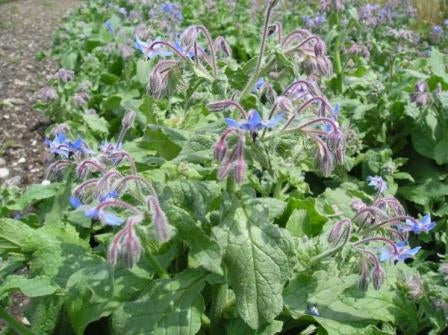BORAGE - kr11
Have a question?

BORAGE - kr11
Dettagli
Scientific name: Borago officinalis, L.
Family: Boragina caea
Brief history and botanical notes on the plant
Borage is an annual herbaceous plant of the Boraginaceae family.
The plant is probably native to the East, and is widespread in much of Europe and Central America, where it still grows spontaneously up to 1000 m above sea level[1]. It is cultivated in all temperate regions of the globe. The name derives from the Latin "borra" (rough woolen fabric), due to the fuzz that covers the leaves. Others derive it from the Arabic abu araq (= father of sweat), through the medieval Latin borrago, perhaps due to the sweat-producing properties of the plant.
Herbaceous plant, often grown as an annual, can reach a height of 80 cm. It has oval elliptical, petiolate, dark green leaves collected in a basal rosette, 10-15 cm long and then smaller on the stem, which have rough hair. The flowers have five petals, arranged in a star, blue-purple in colour, in the center the anthers deriving from the union of the 5 stamens are visible. The flowers are summit, collected in groups, pendulous in full bloom and short-lived. They have long pedicels. The fruits are achenes that contain several small seeds inside them.

PEDOCLIMATIC REQUIREMENTS
It is a rustic plant with no particular needs, it loves moist but well-drained soil (like almost all aromatics) and lots of sun.
SOWING AND TRANSPLANTING TIMES
It occurs by seed, in spring, or by dividing the root tufts. Well-developed plants usually self-seed, so every spring there will be new seedlings; to have a more compact development of the stems it is advisable to trim the plant when it has reached 15-20 cm in height.
PROCESSINGS
It does not require any particular work, its rusticity allows it to grow even in the middle of meadows, a superficial work of the soil is enough.
FERTILIZATION
It does not require particular fertilization, it benefits from nettle macerate.
CULTURAL CARE
Regular watering in the summer period and pruning of the plants for lush vegetation.
CONSOCIATIONS
It is useful to combine borage with the tomato (it acts against certain parasites and supports growth), it keeps parasites away from kohlrabi and other cabbages. Its proximity is also beneficial with courgettes.
ADVERSITY
Hardly affected by animal parasites and fungal diseases.
PRODUCTION AND COLLECTION
The buds and leaves are collected to be consumed fresh throughout the year, except winter in the northern regions. During flowering, the inflorescences are collected and can be consumed fresh or dried.
FOOD USES AND NUTRITIONAL VALUES
The young leaves are variously used in cooking:
The traditional use is in the cooked state of the leaves, which are used in many regional dishes, for minestrone, fillings for ravioli in Liguria (pansoti), cakes and omelettes. Typical is the consumption of flowers and leaves in pancakes (dipped in batter and then fried). Cooking eliminates the fuzz covering the leaves. In moderate quantities the young leaves have been used raw in salads, the flowers are also used occasionally in the same way.
The blue flowers are used to color and garnish dishes, to color vinegar; frozen in cubes they can be a decoration for summer drinks.
Food use in the raw state in significant quantities is precautionarily discouraged, due to the presence in this state, in some vital phases of the plant, of pyrrolizidine compounds, with presumed hepatotoxic activity.
Great commercial interest has emerged, at an international level, in the oil extracted from the seeds: gamma 3 linolenic oil (GLA; 18:3.OMEGA.6), which has very notable uses, especially nutritional, dietary, medicinal, cosmetics. .
This fact has produced a renewed strong interest in the plant, the ease of industrial cultivation of the plant itself being evident, and the fact that the only other easy plant source for this oil are the seeds of Oenothera biennis, but with more complex cultivation , and with lower yields.
Furthermore, the flowers are highly sought after and appreciated by bees, as they have a high quantity of nectar available.
In folk medicine, the leaves and flowering tops are used.
Since ancient times the plant has been reputed to awaken vital spirits (Pliny: “A decoction of borage drives away sadness and gives joy of living”). It is used to reduce fever and calm dry coughs. It is also known as a diuretic and emollient (the latter property is thought to be due to the presence of mucilage). The oil, with a high content of linolenic acid, obtained from the seeds mainly by cold pressing, is used in the treatment of eczema and other skin conditions, due to its strong anti-inflammatory properties.
Currently, the therapeutic use of borage leaves and flowers in the raw state in significant quantities is not recommended, both due to the insufficiency of medical evidence (positive and contraindications) and due to the fact that the raw petals and leaves contain, in quantities not yet well defined, pyrrolizidine alkaloids, with potential hepatotoxic and carcinogenic activity.
BIODYNAMIC TREATMENTS
Apart from the regular use of corn manure and corn silica, no treatments are necessary.
If you choose to reproduce Borage through seed, sowing must be on flower days, if it is propagated by dividing the tufts on a descending moon.


